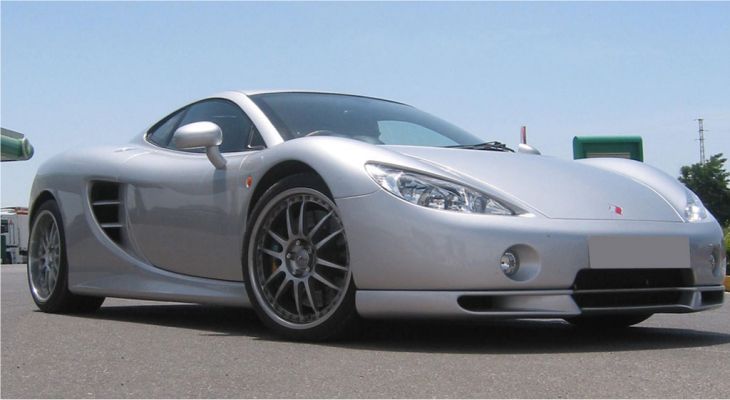The realm of British supercar manufacturing has always been defined by its uncompromising pursuit of excellence. In 2003, Ascari Cars unveiled their masterpiece — the KZ1, a hand-crafted testament to automotive engineering that would redefine the boundaries of exclusive vehicle production.
The story of the KZ1 begins with Dutch racing driver Klaas Zwart’s vision to create something extraordinary. This wasn’t just another supercar; it was a carefully orchestrated symphony of power, precision, and artisanal craftsmanship, limited to a select few fortunate enough to experience its magnificence.
Engineering Excellence: The Heart of a Champion
The KZ1’s soul lies in its naturally aspirated 4.9-liter V8 engine, a masterpiece derived from BMW’s renowned M5 powerplant. With 500 horsepower channeled through a precise 6-speed sequential manual transmission, every component speaks to the pursuit of automotive perfection.
This powerhouse generates 550 Nm of torque at 4,500 RPM, delivering a driving experience that’s both visceral and controlled. The engine’s positioning — mid-longitudinal — creates an ideal weight distribution that racing engineers consider optimal for handling.
“The KZ1’s engine architecture represents a perfect balance between raw power and precise control. It’s one of the most responsive naturally aspirated V8s I’ve ever tested,” notes Marcus Bennett, former F1 powertrain specialist.
The integration of a viscous-coupling limited-slip differential ensures that every ounce of power translates into forward momentum, while the rear-wheel-drive configuration maintains the purity of the driving experience.
Fact!
The KZ1's engine achieves an impressive specific output of 101 horsepower per liter — a remarkable figure for a naturally aspirated engine of its era.
Design & Architecture: Form Following Function
At 4,300mm long and 1,852mm wide, the KZ1’s dimensions strike a perfect balance between presence and purpose. The low-slung profile, measuring just 1,138mm in height, isn’t merely for aesthetic appeal — it’s a calculated decision to optimize aerodynamic efficiency.
The lightweight construction results in a total mass of just 1,350 kg, achieved through extensive use of advanced materials and careful engineering. This impressive weight figure translates to a power-to-weight ratio that puts the KZ1 in elite company.
“The attention to detail in the KZ1’s body construction is exceptional. Each panel isn’t just shaped for aesthetics; it’s engineered for optimal airflow and structural integrity,” shares James Hartley, vintage supercar collector.
The cockpit exemplifies the marriage of luxury and functionality, with every control surface positioned for optimal driver engagement. The two-seater configuration emphasizes the car’s focused nature as a driver’s machine.
Performance Metrics: Beyond Numbers
The KZ1’s performance capabilities extend far beyond mere statistics. The combination of its powerful V8 engine, lightweight chassis, and aerodynamic design creates a driving experience that’s both exhilarating and precise.
Key performance aspects include:
- exceptional power delivery across the rev range;
- precise weight distribution for optimal handling;
- aerodynamic efficiency for high-speed stability;
- responsive throttle mapping for precise control;
- track-oriented suspension geometry.
These elements work in harmony to deliver a driving experience that’s both visceral and controlled.
Important!
The KZ1's chassis dynamics were fine-tuned through extensive testing at Ascari's private race resort in Spain, ensuring optimal performance in both road and track conditions.
Legacy & Impact: A Lasting Impression
The KZ1 represents more than just another entry in the supercar anthology — it’s a blueprint for excellence in limited-production vehicles. Its influence extends beyond its performance figures, setting new standards for hand-crafted excellence.
The car’s legacy lies not just in its rarity but in its approach to supercar design. Each unit required hundreds of hours of skilled craftsmanship, ensuring that no two examples are exactly alike.
“The KZ1 demonstrated that limited production doesn’t mean limited ambition. It pushed boundaries in ways that influenced future supercar developments,” remarks Dr. Thomas Reid, Automotive Heritage Specialist.
This dedication to perfection has made the KZ1 increasingly sought after by collectors who recognize its significance in automotive history.
The Future Through the Lens of Excellence
The Ascari KZ1 remains a testament to what’s possible when engineering excellence meets uncompromising standards. Its influence continues to resonate through the automotive industry, inspiring a new generation of limited-production supercars.
In an era where automotive production increasingly relies on automation, the KZ1 stands as a reminder of the value of human craftsmanship and attention to detail. It represents a philosophy of car building that prioritizes excellence over expediency.
| Pros | Cons |
|---|---|
| Exceptional build quality with hand-crafted attention to detail | Limited availability makes maintenance and parts sourcing challenging |
| Powerful naturally aspirated V8 engine with precise power delivery | High initial cost and ongoing maintenance expenses |
| Optimal weight distribution for superior handling | Limited production run affects parts availability |
| Exclusive production numbers enhance collectibility | Requires specialized knowledge for servicing |
| Advanced aerodynamic design for high-speed stability | Limited dealer network for support |
| Race-derived engineering principles | Relatively unknown brand compared to established supercar manufacturers |
| Unique design that stands out from conventional supercars | Limited track record for long-term reliability |
The Ascari KZ1 represents a unique intersection of racing heritage, engineering excellence, and exclusive craftsmanship. While its limited production run presents certain challenges, these same factors contribute to its status as a highly desirable collector’s item. Its blend of performance, design, and exclusivity continues to captivate automotive enthusiasts and collectors alike, securing its place in the pantheon of extraordinary supercars.

